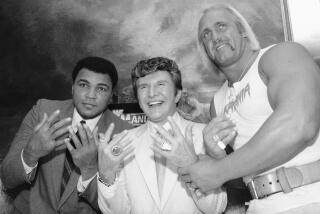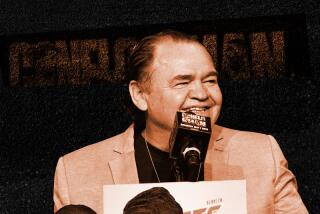REQUIEM FOR A HEAVYWEIGHT : Old-Time Fighters and Fans of the Fight Game Say Goodby to the Big Man Who Helped and Trained Boxers for 60 years
- Share via
They buried Arthur (Duke) Holloway this week, the big man with the big cigar and derby hat who for 60 years trained and nurtured some of the greats and not-so-greats of boxing.
Old-time boxers and others whose lives were touched by the fight game met once more, outside the ring, to say goodby to the man who had wrapped their fists, psyched them up, rubbed them down, but most of all, taught them to be champions.
Holloway, named last year to the World Boxing Hall of Fame, died of a heart attack last week. He was 87.
“He had a habit of calling everybody he came in contact with ‘Champ,’ ” said Sammy Sanders, one of Holloway’s early fighters. “He could take a guy who didn’t know a left hook from a fish hook and train him into a top fighter. He was the cream of the crop in boxing.”
Holloway was born in Milam County, Tex., on Dec. 14, 1900. He picked up his boxing savvy during a 20-year stint in the Navy, during which he won the Navy heavyweight and light-heavyweight championships.
After his discharge, Holloway settled in Los Angeles, where he began training and developing young fighters. As his reputation as a top-notch trainer grew, he began to attract bigger-name fighters.
Holloway trained Joe Louis back into shape after the champion was discharged from the service after World War II. He trained Archie Moore and Sugar Ray Robinson.
Jockey Willie Shoemaker trained as an amateur under Holloway before embarking on a career in horse racing. Jazz musician Miles Davis, a former amateur boxer, would often stop by the gym to hit the speed bag and shadowbox under the trainer’s watchful eye. And former champion Muhammad Ali would go to Holloway for a workout and rubdown to keep in shape after his retirement.
“Duke expected his fighters to be well disciplined, and he was a stickler for the fundamentals,” said Moore, 73, who attended the funeral. “If he was in your corner, that is all a guy needed. He knew how to make a fighter feel important.”
Moore recalled that after a particularly tough fight in Phoenix, he told Holloway that he wanted to quit boxing. But Holloway persuaded him to continue fighting, that things would get better. Moore went on to become light-heavyweight champion from 1952 to 1960.
Holloway made his boxing home at the Main Street Gym, a palace of pugilism where many boxers got their start. It was at Main Street that he could be seen, a towel slung over his shoulder, a cigar dangling from his mouth and a derby perched on his head, encouraging a stable of young amateurs and pros. The gym was demolished in 1984 because it did not meet earthquake standards.
“When Main Street Gym closed, that was the closing of Duke Holloway and the end of a chapter in boxing,” Sanders said. “That’s when he started to lose his interest in boxing.”
He would go to other boxing gyms at Hoover and at 108th streets and Broadway, but they were not the same. Also, Sanders added, the game had changed. “Los Angeles is not able to attract the big fights like Las Vegas and Atlantic City,” he said.
Bell Tribute
More than 150 people packed the Crenshaw Boulevard funeral home where Holloway’s services were officiated by the Rev. Don (Big Red) Grant, a former light-heavyweight. Joey Olmos, chief inspector of the state Athletic Commission, rang a bell 10 times in a final tribute to the trainer. Six former boxers were pallbearers. A veterans’ group performed a 21-gun salute. The burial was at Inglewood Park Cemetery.
“Duke was a master teacher, not just a trainer, not just a motivator, but a master teacher,” Olmos said.
“He was the kind of trainer who would go the commission and have a fighter’s license revoked if he felt that the fighter’s career was over,” he said. “He would tell the fighter, ‘Son, I’m sorry, but you couldn’t lick your lips.’ ”
“He opened his house to fighters, he let them live with him, eat his food. He never made a lot of money, never wanted a lot of money. He just loved boxing,” said John Calloway, a trainer.
Racial Barriers
When there were strict racial barriers in the boxing profession, Holloway was one of the few black trainers to develop a stable of young white fighters.
“Sometimes they wouldn’t allow him into the stadium to see his fighters box, so he would sit outside on the curb and quiz the patrons about how his fighters were doing,” Calloway said.
During one bout in Texas, Calloway recalled, one white boxer refused to fight after Holloway was denied a hotel room because he was black. “They gave him a room,” Calloway said.
Grant, who conducted the services, fought for Holloway before joining the ministry. “He had a way of helping boxers make the transition from the ring, with the crowds, to the time when there is no cheering crowd,” he said. “The Duke would say that he would rather be a has-been than a might-have-been because a might-have-been has never been.”
After the funeral, family and friends gathered at Holloway’s house to exchange memories and pay their respect. Holloway is survived by his sister, Bessie Jones Holloway of Houston, and nieces, nephews and cousins.
“He was like a father to all of us,” said Johnny Smith, 50, a former light-heavyweight. “I remember a fight in Sacramento. The Duke was in my corner when I came back and I told him, ‘I think I broke my hand.’ He said, ‘That’s all right, you have another one,’ and sent me back to fight. And I knocked the guy out with the other hand.”
Irish Roy Smith, 56, a former light-heavyweight and heavyweight, fought with Duke for five years. Smith worked with Holloway during the end of his boxing career, which included 134 fights from 1957 to 1969.
Fight With Elvis
“The Duke always had a group of fighters trying to get his attention,” Smith said. Smith fought his most famous bout on the movie screen, when he fought Elvis Presley in “Kid Galahad” in 1962. “They wanted a heavy guy to fight Elvis in the movie,” he said. “It was fun, but had I really hit him, I don’t think he would have been doing much singing.”
Smith and a group of other former fighters bought brandy and raised it to toast Holloway.
Sanders recalled a story Holloway used to tell about his Navy discharge in the 1930s. “When he was discharged, a doctor told him that he wouldn’t live long if he didn’t stop drinking and smoking cigars,” Sanders said. “A few years passed, and he said he went back and learned that that doctor had died and they assigned him a new doctor who gave him the same warning. After a while that doctor died, too. Then he said, ‘You know, since I been out of the hospital, I had five doctors, and all five of them told me the same thing, and all of them are dead. I outlived all them.’ ”
The boxers laughed and raised another toast.
More to Read
Go beyond the scoreboard
Get the latest on L.A.'s teams in the daily Sports Report newsletter.
You may occasionally receive promotional content from the Los Angeles Times.










